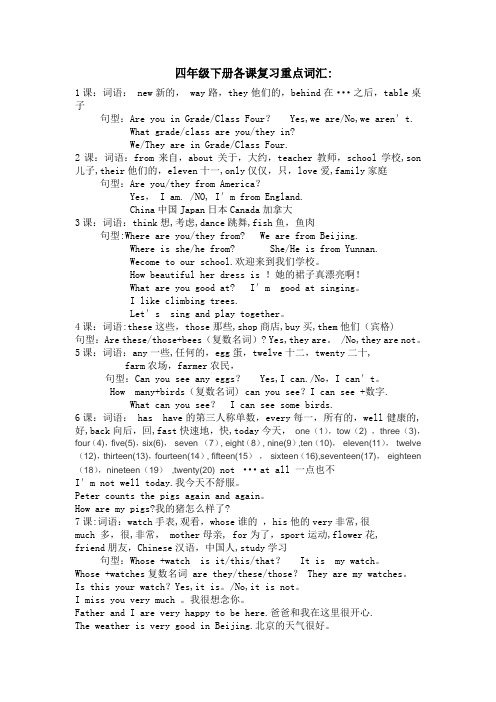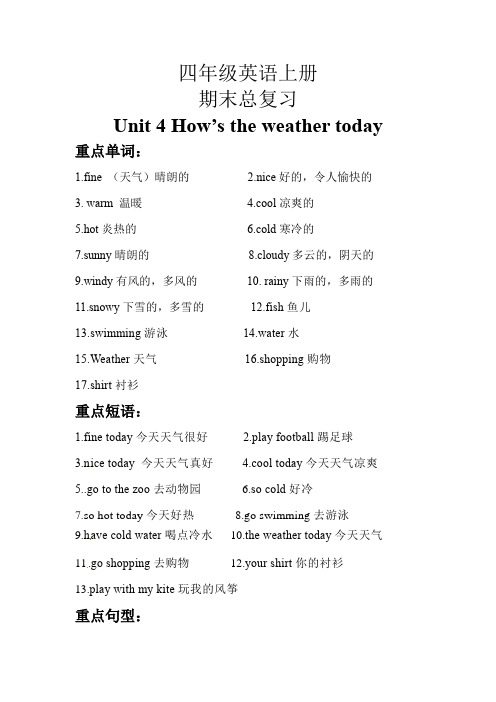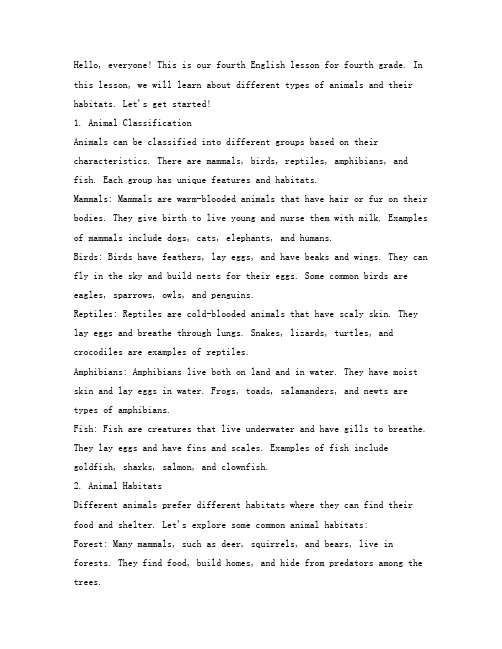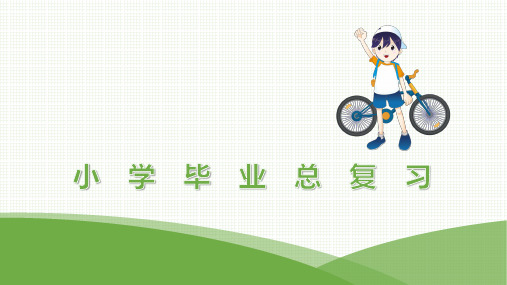小学四年级英语第4课复习资料
科普版四年级英语下册各课复习重点词汇及句型

四年级下册各课复习重点词汇:1课:词语: new新的, way路,they他们的,behind在···之后,table桌子句型:Are you in Grade/Class Four? Yes,we are/No,we aren′t.What grade/class are you/they in?We/They are in Grade/Class Four.2课:词语:from来自,about关于,大约,teacher教师,school学校,son 儿子,their他们的,eleven十一,only仅仅,只,love爱,family家庭句型:Are you/they from America?Yes, I am. /NO, I′m from England.China中国Japan日本Canada加拿大3课:词语:think想,考虑,dance跳舞,fish鱼,鱼肉句型:Where are you/they from? We are from Beijing.Where is she/he from? She/He is from Yunnan.Wecome to our school.欢迎来到我们学校。
How beautiful her dress is !她的裙子真漂亮啊!What are you good at? I′m good at singing。
I like climbing trees.Let′s sing and play together。
4课:词语:these这些,those那些,shop商店,buy买,them他们(宾格)句型:Are these/those+bees(复数名词)? Yes,they are。
/No,they are not。
5课:词语:any一些,任何的,egg蛋,twelve十二,twenty二十,farm农场,farmer农民,句型:Can you see any eggs? Yes,I can./No,I can′t。
【强烈推荐】陕旅版四年级上册英语复习资料

陕旅版四年级上册英语复习资料姓名: __________________ Lesson 1第一课:Look at the picture of my family!1.Family家庭F ather a nd m other I l ove y ou. 爸爸妈妈我爱你们。
记忆的时候取每个单词的首字母哦!2. Father父亲,口语中常说dad爸爸Mother母亲,口语中常说mum妈妈3. Look看,看东西look at +要看的东西,例如看我的书包look at my bag.4. 我的全家福the picture of my family,其他人的把my代替,如她的全家福可以说the picture of her family,他的全家福the picture of his family。
5. 所有格’s表示物品归某人所有,比如小明的,在小明名字后+’s,XiaoMing’s,叔叔的在叔叔后面+’s,uncle’s。
6. 介绍用语:is是这是This is …例This is my mum.这是我的妈妈。
那是That is …例That is my dad.那是我的爸爸。
表示的都是一个,单数Lesson 2第二课’s family.1. Who谁uncle叔叔舅舅aunt阿姨婶婶cousin堂兄弟,堂兄妹tall高的2. 句型Who’s that?那是谁?Who’s this? 这是谁?3. He他she她, 提问她/他是谁,替代这个this和那个that。
Who’s he? 他是谁?Who’s she? 她是谁?4. ’s family. 来看看我叔叔的家。
Lesson 3第三课I love them!1. Grandpa爷爷grandma奶奶love爱lovely可爱的kind和蔼的friend朋友friendly友好的they: 他们,它们,她们are是,复数,强调两个以上2. Who are they? 他们是谁?3. I love them. 我爱他们。
【期末复习】知识梳理+巩固练习 四年级英语上册Unit 4 人教精通版(三起)含答案

四年级英语上册期末总复习Unit 4 How’s the weather today 重点单词:1.fine (天气)晴朗的2.nice好的,令人愉快的3.warm温暖4.cool凉爽的5.hot炎热的6.cold寒冷的7.sunny晴朗的8.cloudy多云的,阴天的9.windy有风的,多风的10.rainy下雨的,多雨的11.snowy下雪的,多雪的12.fish鱼儿13.swimming游泳14.water水15.Weather天气16.shopping购物17.shirt衬衫重点短语:1.fine today今天天气很好2.play football踢足球3.nice today 今天天气真好4.cool today今天天气凉爽5..go to the zoo去动物园6.so cold好冷7.so hot today今天好热8.go swimming去游泳9.have cold water喝点冷水10.the weather today今天天气11.go shopping去购物12.your shirt你的衬衫13.play with my kite玩我的风筝重点句型:1.—今天天气很好我们踢足球吧?—太好了!—It's fine today. Let's play football!—Great!2.—今天天气真好我们玩我的风筝吧? —好的我们走吧!— It's nice today. Let' splay with my kite?—OK.Let's go !3.—妈妈今天天气凉爽我们去动物园好吗? —好的。
—Mum, it's cool today . Shall we go to the zoo ?— OK!4.—爸爸今天好热我们去游泳好吗?—好主意我们走吧。
—Dad, it's hot today. Shall we go swimmin g?—Good idea! Let's go.5.—妈妈今天天气怎么样? —天气晴朗我们去购物吧。
四年级下英语Unit4-经典教学教辅文档

Unit 4 At the farmB Let’s learn Draw and sayTeaching Aims:1.Students can listen, speak, read and write the key words:horse, cow, hen, sheep and their plural form.2.Students can master the sentences:“W hat is this? It’sa…. What are these? These are….”3.Students can use these key words and sentence to ask andanswer.Teaching Important Point:Students can master the words and sentences: horses, cows, hens, sheep. What is this? It’s a…. What are these? These are….Teaching Difficult Point:Students can use these key words and sentences to introduce the farm.Teaching Aids:PPT, VideoTeaching Procedures:Step 1 Warm-up1.Greetings.2.Sing a song “M ary had a little lamb”Step 2 PresentationB L et’s learn1.Look at some pictures about farm.2.Let’s students listen and asks:T: Listen! What is this?Ss: Hen.T: Yes, it’s a hen. Look at this picture. W hat are these? Ss: These are hens.T: These are hens. They are so fat.(Write down the key words on the blackboard and teaches.) T: Look, what’s this?S1: It’s a hen.T: What are these?S2: These are hens.3.Teacher plays the sound and asks:T: What’s this?Ss: Horse.T: Yes, it’s a horse. What are these?Ss: These are horses.T: Very good. These are horses.(Write down the key words on the blackboard and teaches.)4.Play a game “High and low voice.”5.Teach “cow, sheep” in the same way.6.Read the words and sentences together.Step 3 Practice1.Let’s sayAsk some students to say the sentences: It’s a…. They’re….2.Look, count and sayShow a picture, let students look at the pictureand answer the question: How many ...... in the picture? 3.Let’s guessShow some sentences, then let students guess what kind of animal it is.Step 4 ConsolidationDraw and sayLet students draw a farm. They can draw some animals or plants, then introduce ask some students to introduce their farm.Step 5 SummaryIn this class, we learned some key words and sentences: cows, hens, horses, sheep. “What is this? It’s a ... What are these? These are...Step 6 Homework1.Copy the key words eight times.2.Introduce the animals or plants on your farm to your classmates .Blackboard DesignUnit 4 At the farmWhat is this?It’s a hen horse cow sheepWhat are these?These are hens horses cows sheep。
四年级上册英语书第四面

四年级上册英语书第四面的知识点总结如下:一、单词与短语1. 动物类单词:cat [kæt] 猫dog [dɒɡ] 狗pig [pɪɡ] 猪cow [kaʊ] 牛sheep [ʃiːp] 羊例句:I have a cat and a dog. They are my best friends.(我有一只猫和一只狗。
它们是我最好的朋友。
)2. 颜色类单词:red [red] 红色green [ɡriːn] 绿色blue [bluː] 蓝色yellow ['jeləʊ] 黄色orange ['ɒrɪndʒ] 橙色例句:The apple is red and the banana is yellow.(这个苹果是红色的,这个香蕉是黄色的。
)3. 日常用品单词:book [bʊk] 书pen [pen] 钢笔pencil ['pensl] 铅笔ruler ['ruːlə] 尺子eraser [ɪ'reɪzə] 橡皮例句:I use a pen to write in my book.(我用钢笔在书上写字。
)二、基本句型结构1. 陈述句:用于描述事实或状态。
主语+ 谓语+ 宾语例子:I have a book.(我有一本书。
)2. 疑问句:用于询问信息。
Do/Does + 主语+ 动词原形+ 其他?例子:Do you have a cat?(你有一只猫吗?)3. 否定句:表示否定意义。
主语+ don't/doesn't + 动词原形+ 其他例子:I don't have a dog.(我没有一只狗。
)三、语音知识1. 元音发音:注意单词中元音的发音,如cat中的[æ],dog中的[ɒ],red中的[e]。
2. 辅音发音:注意辅音的清晰发音,如book中的[b]和[k],pen中的[p]和[n]。
四、语法点1. 第三人称单数:当主语是第三人称单数(he, she, it)时,动词需要加s或es。
4年级上册英语第四课

四年级上册英语第四课课堂笔记一、本课重点1.词汇:学习本课新词汇,如“dog”、“cat”等。
2.句型:掌握本课重点句型,如“What's this?”、“It's a/an...”等。
3.语音:学习本课新音标,练习发音。
二、课堂笔记1.导入新课(1)老师播放歌曲《Old MacDonald Had a Farm》,带领学生跟唱,活跃课堂气氛。
(2)老师展示本课课题,并介绍本课学习内容。
2.学习新词汇(1)老师展示动物图片,教授新词汇“dog”、“cat”等。
(2)学生跟读,模仿发音。
(3)老师和学生进行互动游戏,巩固新词汇。
3.学习重点句型(1)老师教授重点句型“What's this?”、“It's a/an...”,并进行示范。
(2)学生模仿发音,进行替换练习。
(3)老师和学生进行角色扮演游戏,练习重点句型。
4.学习新音标— 1 —(1)老师教授本课新音标,并进行示范。
(2)学生跟读,模仿发音。
(3)老师播放录音,学生进行听力练习。
5.课文学习(1)老师播放课文录音,学生跟读。
(2)老师对课文进行解释,学生理解课文意思。
(3)学生进行分组朗读比赛,巩固课文内容。
6.课堂小结(1)老师对本课学习内容进行小结。
(2)老师布置课后作业:抄写本课重点词汇和句型,听录音跟读课文。
(3)老师鼓励学生积极参与课堂活动,表扬表现优秀的学生。
7.拓展学习(1)老师介绍一些与本课动物相关的英文儿歌或故事,增强学生对英语学习的兴趣。
(2)老师展示一些动物图片的英文名称,让学生尝试用英语描述动物的特征和习性,培养学生的英语口语表达能力。
8.互动交流(1)老师邀请学生分享自己喜欢的动物,并用英语简单描述原因,鼓励学生运用所学知识进行表达。
— 2 —(2)老师组织学生进行小组合作活动,让学生用英语讨论并编写一个关于动物的小对话或短文,培养学生的英语合作与创新能力。
9.文化拓展(1)老师介绍一些中外动物文化的差异,如中国的十二生肖和西方的动物象征等,拓宽学生的文化视野。
四年级英语第四课

Hello, everyone! This is our fourth English lesson for fourth grade. In this lesson, we will learn about different types of animals and their habitats. Let's get started!1. Animal ClassificationAnimals can be classified into different groups based on their characteristics. There are mammals, birds, reptiles, amphibians, and fish. Each group has unique features and habitats.Mammals: Mammals are warm-blooded animals that have hair or fur on their bodies. They give birth to live young and nurse them with milk. Examples of mammals include dogs, cats, elephants, and humans.Birds: Birds have feathers, lay eggs, and have beaks and wings. They can fly in the sky and build nests for their eggs. Some common birds are eagles, sparrows, owls, and penguins.Reptiles: Reptiles are cold-blooded animals that have scaly skin. They lay eggs and breathe through lungs. Snakes, lizards, turtles, and crocodiles are examples of reptiles.Amphibians: Amphibians live both on land and in water. They have moist skin and lay eggs in water. Frogs, toads, salamanders, and newts are types of amphibians.Fish: Fish are creatures that live underwater and have gills to breathe. They lay eggs and have fins and scales. Examples of fish include goldfish, sharks, salmon, and clownfish.2. Animal HabitatsDifferent animals prefer different habitats where they can find their food and shelter. Let's explore some common animal habitats:Forest: Many mammals, such as deer, squirrels, and bears, live in forests. They find food, build homes, and hide from predators among the trees.Desert: Reptiles like snakes and lizards are adapted to desert habitats. They can withstand high temperatures and lack of water. Camels are another animal found in deserts.Ocean: The ocean is home to a wide variety of sea creatures, including fish, dolphins, whales, and sharks. They live in different zones of the ocean, such as coral reefs or the deep sea.Pond: Amphibians like frogs and toads can be found in ponds. They lay their eggs in the water and feed on insects and plants in and around the pond.Grassland: Many birds, such as eagles and ostriches, live in grasslands. They can find food easily and have open spaces to build their nests.3. ConclusionIn this lesson, we have learned about different types of animals and their habitats. Remember, animals are classified into groups based on their characteristics, and each group has its own distinct features. Animals also adapt to different habitats according to their needs. Understanding these concepts will help us appreciate the diversity of the animal kingdom.I hope you enjoyed this lesson! Don't forget to review and practice what you have learned. Keep exploring the wonderful world of animals!。
Unit 4 (复习课件)四年级英语上册(人教PEP版)

【习题演练】 一、单选题 1.Go to the _____. Take a shower.
A.bedroom B.study C.bathroom 2.Go to the _________ and cook dinner. A.kitchen B.study C.bathroom
C.sofa
Part three
精讲精练
Grammar 1
1.Is she in the living room? 她在客厅里吗? 析句型: “Is+人/物(单数)+表示位置的介词短语?” 用于确认某人或某物的位置。 肯定回答:“Yes, he/she/it is.”, 否定回答:“No, he/she/it isn't.’。
【习题演练】
二、写出问答句
3.Are they his glasses? (作肯定回答)
_Y_e__s__, _t_h_e__y_ are.
4.Are they under the bed? (作肯定回答)
Y__e_s_,__t__h_e_y___a_r_e_._________
Grammar 4
___-_N__o_,__s_h__e__is_n__’t_.__________________
Sentences
4. 她在厨房里。
___S_h__e_’s__i_n__t_h__e__k_i_t_c_h_e_n_.________________
5.请打开门。
___O_p_e__n__t_h_e__d__o_o_r_,_p_l_e_a_s_e__._________
最新人教pep版小学英语毕业课本知识点单元复习第4课时四年级上册 Unit 4~Unit 6

返回目录
4. A: What would you like for dinner? 晚餐你想吃 什么? 重 B: I'd like some rice and vegetables. 我想要一些米 点 饭和蔬菜。 句 子 5. Help yourself. 随便吃吧。 6. A: Would you like some beef? 你想要一些牛肉吗?
B: She's a nurse. 她是位护士。
返回目录
词句综合运用
一、Read, fill and choose. 读一读,填一填。看图,并根据句子 意思在横线上填写合适的单词,并将相应的字母编号填在图片 下方的括号内。
(A )
( B ) ( D)
( E ) ( C)
返回目录
(J) (I )
(F )
(G )
(H )
返回目录
A. We can watch TV in the ____l_iv_i_n_g__ro_o_m_________. B. I'd like to take a shower. I will go to the ______b_a_t_h_ro_o_m_____. C. Sarah feels sleepy. She should go to the ____b__e_d_ro_o_m_______. D. It's time to do homework. Let's go to the ________s_tu__d_y_____. E. I'm hungry. My mother is cooking food for me in the ______k_i_tc_h_e_n______. F. Tom is sitting beside his mother on the ____s_o_fa____. G. She was tired. She went into her bedroom and lay down on the _____b__ed___.
冀教版小学英语四年级上册第四课Book3_Lesson4_Shoes_and_Socks

Lesson 4 Shoes and Socks
What’ s this ?
This is a dress .
What are these ?
These are dresses
What’ s this ?
This is a sock .
What are these ?
These are socks .
What’ s this ?
This is a shoe .
What are these ?
These are shoes .
What are these ?
These are shorts .
Difference between skirt and dress
他们 He is wearing __s_h_o_rt_s_ . He is cool. 他很酷。
She is wearing __a_ _d_re_s_s_. She looks nice. 她看起来很漂亮。
Part 2 Let’s do it!
What is this? This is a dress. This is a skirt.
Difference between cap and hat
cap
hat
s
分类 this or these
t
T
it(它) this 单数
sk
these 复数 they他们 g
sh sw
c
so
s
sc
d
co
This is a/an __ .
These are ____ .
What are they wearing?
四年级上册第四课英语

四年级上册第四课英语Unit 4 Lesson 4: English in the First GradeIn the first grade, students are introduced to basic English vocabulary and conversational phrases. This lays a strong foundation for their English language learning journey. Let’s explore the key topics covered in the fourth lesson of the first grade English textbook.The lesson begins with an introduction to English greetings and responses. Students learn how to say "hello," "hi," "good morning," and "goodbye." They also learn to respond with appropriate phrases such as "hello," "hi," "good morning," and "goodbye" too. This enables them to greet their teachers and classmates in English with confidence.Next, the lesson focuses on basic classroom instructions and responses. Students are taught phrases like "sit down," "stand up," "open your book," "close your book," and "listen" to follow instructions. They learn to respond with phrases like "yes, teacher," and "ok, teacher." These classroom instructions and responses help create a conducive English-speaking environment in the classroom.Moving on, the lesson introduces vocabulary related to colors. Students are taught basic colors such as red, blue, green, yellow, orange, purple, pink, black, and white. This vocabulary expansion enhances their ability to describe objects and identify colors in English. Colorful pictures are used to make the learning process engaging and visually stimulating.The fourth lesson also covers the topic of numbers. Students learn to count from one to ten. They are introduced to numbers through visual aidsand repetition exercises. Learning how to count in English helps students develop their number recognition skills and lays the groundwork for further mathematical concepts.Furthermore, the lesson introduces simple verbs related to actions. Students learn verbs such as run, jump, walk, and read. These verbs are accompanied by corresponding pictures, allowing students to associate the verb with its action. This vocabulary expansion increases their ability to describe actions and engage in simple conversations.To reinforce the vocabulary and phrases learned in the lesson, interactive activities and games are incorporated. These activities encourage student participation and enable them to practice using the newly acquired language skills in a fun and interactive manner. Students engage in role-plays, group discussions, and language games to strengthen their understanding and retention of the lesson content.In conclusion, the fourth lesson of the first grade English textbook equips students with essential vocabulary and conversational phrases. It lays a strong foundation for their English language learning journey by introducing greetings, classroom instructions, colors, numbers, and basic action verbs. The use of visual aids, repetition exercises, and interactive activities enhances the learning experience and allows students to engage actively in the lesson. By mastering these fundamental language skills, students are prepared to progress further in their English language learning as they move up to higher grades.。
四年级下册的英语书第四课课文

四年级下册的英语书第四课课文
外研版四年级下册的英语书第四课课文笔记可以包括以下几个部分:
一、重点单词和短语
掌握本课新学的单词和短语,如“playground”、“library”等。
注意单词的发音和拼写,可以在课后进行抄写和背诵。
二、重点句型
掌握本课出现的重点句型,如“This is the playground/library/…”等。
学会运用这些句型进行简单的对话和表述。
三、语法知识
了解本课中出现的语法知识,如名词的单复数形式、冠词的用法等。
在课后进行相关的语法练习,加深对语法知识的理解。
四、课文理解
认真阅读课文,理解课文的大意和主题。
学会从课文中获取信息,回答相关的问题。
五、拓展知识
了解与本课主题相关的拓展知识,如学校的其他场所、设施等。
通过互联网、图书馆等途径获取更多的信息,丰富自己的知识储备。
以上是外研版四年级下册英语书第四课课文笔记的一些建议,希
望能对您有所帮助。
当然,具体的笔记内容还需要根据您的实际情况和学习需求进行调整和完善。
四年级上册英语第4课

四年级上册英语第4课一、教学目标1. 掌握本课生词和短语,了解课文中涉及的语法知识。
2. 学会运用本课所学知识进行口语交流,并能完成相应的写作任务。
3. 培养学生的听、说、读、写能力,激发他们对英语学习的兴趣。
二、教学内容1. 学习本课生词和短语,掌握单词的拼写和发音。
2. 学习课文中的对话和句型,了解其中涉及的语法知识。
3. 进行口语交流练习,让学生能够熟练地运用所学知识进行日常交流。
4. 完成相应的写作任务,提高学生的写作能力。
三、教学重点与难点1. 掌握本课生词和短语,了解课文中涉及的语法知识。
2. 学会运用本课所学知识进行口语交流,并能完成相应的写作任务。
3. 理解课文中的长句和难句,并能够正确运用。
四、教学方法与手段1. 采用多媒体课件进行教学,结合图片、音频和视频等多种形式,让学生更加直观地了解课程内容。
2. 通过情景模拟、角色扮演等方式,让学生参与到课程中来,增强学生的参与感和体验感。
3. 采用小组合作学习的形式,让学生互相帮助、互相学习,提高学习效果。
4. 布置相应的课后作业,加强学生对课程内容的巩固和复习。
五、教学步骤与过程设计1. 导入新课:通过问题导入、图片展示等方式引入本课的主题和内容。
2. 学习生词和短语:通过单词卡片、PPT等形式展示本课生词和短语,并带领学生朗读和拼写。
3. 学习课文:通过听录音、跟读、角色扮演等方式让学生熟悉课文内容,并带领学生学习其中的语法知识和长句、难句。
4. 口语交流练习:通过小组合作、角色扮演等方式让学生进行口语交流练习,加强学生对本课所学知识的运用能力。
四年级上册科普版第4课单词拼读

四年级上册科普版第4课单词拼读在四年级上册的科普版教材中,第四课主要介绍了一些常见的英语单词以及它们的拼读规则。
单词的拼读是英语学习中非常重要的一部分,它直接关系到学生的阅读和写作能力。
通过学习这些单词的拼读规则,学生可以更准确地拼写单词,提高阅读和写作的效率。
在本文中,我们将对四年级上册科普版第4课单词拼读进行详细的介绍和解析。
一、单音节词的拼读规则1. 单元音字母单元音字母包括a、e、i、o、u。
当它们出现在单词中间时通常由元音字母发音,例如cat(/kæt/), bed(/bed/), big(/bɪg/), hot(/hɒt/), run(/rʌn/)。
2. 辅音字母和元音字母的组合当辅音字母和元音字母组合在一起时,通常由元音字母发音。
a 后面接辅音字母m时,发音为/am/,am; e后面接辅音字母t时,发音为/et/,et; i后面接辅音字母t时,发音为/ɪt/,it; o后面接辅音字母g时,发音为/ɒg/,og; u后面接辅音字母g时,发音为/ʌg/,ug。
二、多音节词的拼读规则1. 长元音和短元音长元音和短元音在多音节词的拼读中非常重要。
长元音通常由两个字母表示,而短元音通常只由一个字母表示。
cake中的a为长元音,发音为/keɪk/; cat中的a为短元音,发音为/kæt/。
2. 辅音字母和元音字母的组合在多音节词中,辅音字母和元音字母的组合不仅要注意元音字母的发音,还要注意辅音字母的发音。
ea组合在一起的时候可以发音为/ɪə/,/eə/,/eɪ/,/æ/,具体的发音还要根据具体情况而定。
三、单词拼读的练习方法1. 阅读练习通过大量的阅读练习,学生可以熟悉单词的拼读规则,培养自己的阅读能力。
2. 拼写练习学生可以通过听音填空、单词拼写等练习来巩固单词的拼读规则,提高自己的拼写能力。
3. 语音练习学生可以通过模仿老师的发音或者录音对比的方式来训练自己的语音,提高自己的发音准确性。
冀教版四年级英语上册第四课

冀教版四年级英语上册第四课学习内容一、单元主题本单元主题是“介绍自己”,旨在通过学习如何用英语进行自我介绍,提高学生对英语表达的兴趣和自信心。
二、重点单词1. 姓名:例如“John”、“Mary”等。
2. 年龄:例如“seven”、“nine”等。
3. 颜色:例如“red”、“blue”、“green”等。
4. 喜好:例如“reading”、“swimming”、“cooking”等。
三、重点句型1. My name is ____. 我的名字是____。
2. I’m ____ year s old. 我____岁了。
3. My favorite color is _____. 我最喜欢的颜色是____。
4. I like ____. 我喜欢____。
5. What’s your name? 你叫什么名字?6. How old are you? 你多大了?7. What’s your favorite color? 你最喜欢的颜色是什么?8. What do you like? 你喜欢什么?四、语法点1. 人称代词:本单元将学习到人称代词的基本用法,包括“I”、“you”、“he”、“she”、“it”、“we”、“they”等。
2. 形容词性物主代词:例如“my”、“your”、“his”、“her”、“its”、“our”、“their”等。
3. 句子结构:学生将学习到简单句子的基本构成,如主语+谓语、主语+谓语+宾语等。
五、语音知识本单元将学习到一些基本的发音规则,如元音字母在开音节和闭音节中的发音、辅音字母的发音等。
学生将通过模仿和练习,提高自己的英语发音水平。
六、文化知识本单元将涉及到一些文化知识,如不同国家的姓名构成、不同年龄阶段的兴趣爱好等。
学生将了解并尊重不同文化之间的差异,培养跨文化交流的意识。
七、写作练习学生将根据本单元所学内容,完成一篇自我介绍的短文。
通过写作练习,学生将巩固所学知识,提高英语写作能力。
科普版四年级英语下册第四课

Japan/dʒə'pæ n/
• 日本 • 东京塔 • 桂离宫
加拿大 国会大厦
• 澳大利亚 • 悉尼歌剧 院
Hello,boys and girls. Who is he ? Yes。he is Sunwukong.
Where is he form? He 's form China.
Where is he from? He’s from Janpa.
the USA
New York /jɔ:k/ Where are you from? We are from ______. Are you from ______? Yes, we are./ No, we aren’t. Where is he from? (she) He is from ______. Is he from _______? Yes, he is./ No, he isn’t.
• about me (宾格 • Welcome to our school. • at school/home • be good at 擅长 • We are all girls/boys. • China • I am from Jiang X
• be from = • come from
I can read
G: I’m from Yunnan. Where are you from? D: We are from Beijing.
L: Are you new here!
G: Yes, our shool.
G: Thank you.
欢迎来到我们学校!
China /tʃaɪnə/ Beijing Where are you from? We are from ______. Are you from ______? Yes, we are./ No, we aren’t. Where is he from? (she) He is from ______. Is he from _______? Yes, he is./ No, he isn’t.
- 1、下载文档前请自行甄别文档内容的完整性,平台不提供额外的编辑、内容补充、找答案等附加服务。
- 2、"仅部分预览"的文档,不可在线预览部分如存在完整性等问题,可反馈申请退款(可完整预览的文档不适用该条件!)。
- 3、如文档侵犯您的权益,请联系客服反馈,我们会尽快为您处理(人工客服工作时间:9:00-18:30)。
She likes PE and Art. Because PE is fun.
4. Does Alice like PE?
Yes, she does.
1. What is this?
It’s a timetable.
2. How many lessons does Kitty have?
1 2
Chinese Music
5. I like Reading Class. I like reading. I read books every day.
6. I like Science . I can learn about many animals and plants in Science Class.
7.I like Music. I like singing. I can sing very well. I join the music club. 8.I like Maths. I can have fun with numbers in Maths class. 9.I like Chinese. I like reading stories.
和父母对话: A: Good morning, _____. B: Good morning,______. What lessons do you have today? A: I have _____, _____, _____ and ___in the morning. And I have_____, _______and ____in the afternoon. Timetable B: What subjects do you like? English A: I like__________ and___________. Chinese B: What about you? Maths PE A: I like____________. _____________is fun. Moral class I don’t like____________. Maker class
3. I like Art. Art is fun. I like drawing/ I like painting. I can draw nice pictures. I join the art club.
4. I like Music Class. Music is fun. I like playing the piano. I can play the piano very well.
3 4
5 6 7
Maths English
Art Music PE
She has ______ lessons.
3. What does she have in the morning?
She has ____, ____ ,____and _____.
4. What does she have in the afternoon?
提示: 喜欢什么科目,要说理由: 可以参考看 PPt (8--10)
Chinese
Read Page P18 Then answer the following qu It’s a timetable.
2. How many lessons do they have?
She has ___, ____ and_____.
补充
1.I like PE. PE is fun. I like playing football in the playground. I join the sports club.
2. I like PE. PE is fun. I can run very fast and jump very high .
They have six lessons.
3. What do they have in the morning?
They have Chinese, Maths, English and Science.
4. What do they have in the afternoon?
They have PE and Music.
10.I like English. It sounds beautiful. It’s very useful.
11. What’ s your favourite subject? My favourite subject is English. 12. I don’t have any lessons today. I don’t have any lessons in the afternoon/ in the morning
Subjects
4
Period 2
Subjects
English Maths Science Chinese PE Art Music
足球课 篮球课 信息课 班会课 阅读课 口语课 书法课 创客课 思品课 烘焙课 整理课 Football class Basketball class Computer class Class meeting Reading class Oral Class Handwriting class Maker class Moral class Baking class Packing class
1. What lessons does Peter like? He likes Chinese and Maths.
2. What lessons does Joe like?
He likes maths and Science.
3. What lessons does Alice like?
